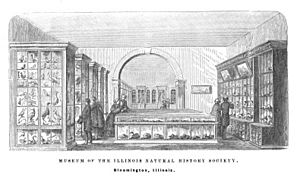Illinois Museum of Natural History facts for kids
The Illinois Museum of Natural History was a special place for learning about nature. It started in 1858 in Bloomington, Illinois. Back then, it was called the Museum of the Illinois State Natural History Society. It was located at the Illinois Normal School.
The museum was on the third floor of a building known as Old Main. This building later became part of Illinois State University. The museum welcomed visitors until 1877. The Old Main building itself was taken down in 1958.
Contents
How the Museum Started
In December 1857, teachers met in Decatur, Illinois. A man named Cyrus Thomas from Carbondale shared an idea. He suggested creating a State Natural History Society. He also thought the State Normal School would be a great home for its museum.
People liked his idea! A meeting was held in Bloomington on June 30, 1858. They decided how the society would work and chose leaders. Professor J. B. Turner became the first president.
Growing Interest in Nature
The society held yearly meetings. More and more people joined each time. This showed how much interest there was in nature. People gave talks on many topics. For example, President J.B. Turner spoke about "Microscopic Insects." Dr. Frederick Brendel talked about "Forests or Forest Trees."
The Normal University building was designed with a large hall for the museum. It was 100 feet long and 33 feet wide. Charles D. Wilber worked very hard for the society. He helped collect almost 60,000 items in just two years!
The Museum's Library
The society also planned a library. They wanted to collect books about natural history and science. The library started with 300 books. Ira Moore was the first librarian.
What the Museum Looked Like
The State Normal University became the official home for all the collections. These collections included items from the society and donations. Two large halls in the university building were joined together. This created a huge gallery, 100 feet long and 33 feet wide.
This hall was called the Museum of Geology and Natural History. Richard H. Holder from Bloomington designed it. He visited other famous museums for ideas. These included the Philadelphia Academy of Sciences and the Boston Academy.
Inside the Museum
The museum had special glass cases for its displays. Along the windows, there were twelve large glass cases. Each was four feet wide, eight feet long, and ten feet tall. These cases were for the Ornithology department, which studies birds.
Inside these clear glass cases, birds were arranged by family. Each bird had its name and where it lived. At first, most of the birds were from Illinois.
Across an aisle, there were twelve more glass cases. These were for other types of specimens. They were three feet wide and twelve feet long. On top, they had smaller glass display cases. These lower spaces held large fossils. For example, they had ancient plant fossils like Lepidodendra and Sigillaria. These were too big to fit on shelves.
Important People at the Museum
Many important people were involved with the museum and the society. Here are a few:
- Richard Edwards (educator): He joined the Illinois Natural History Society in 1862. He was also part of the Illinois State Teachers' Association.
- Stephen Alfred Forbes: He became the first chief of the Illinois Natural History Survey.
- John Wesley Powell: This famous educator and explorer helped the museum grow. He also worked as a curator, which means he took care of the collections.
- Almon Harris Thompson: He was named acting curator in 1869.
- George Vasey: He was one of the founding members of the society.
See also


